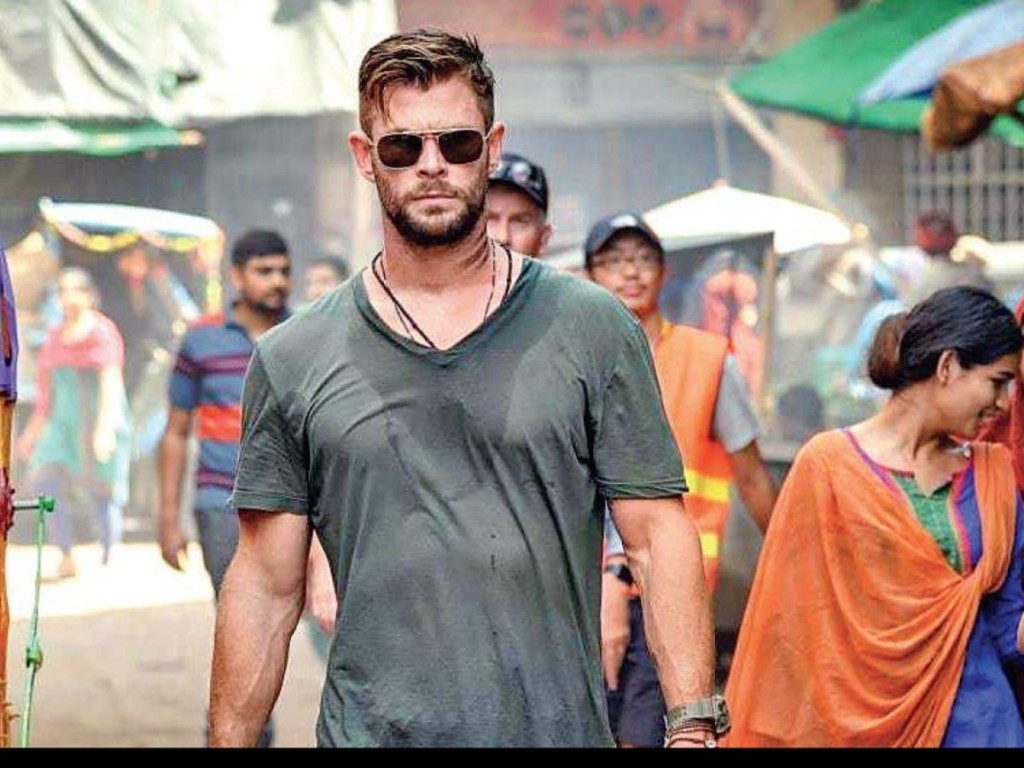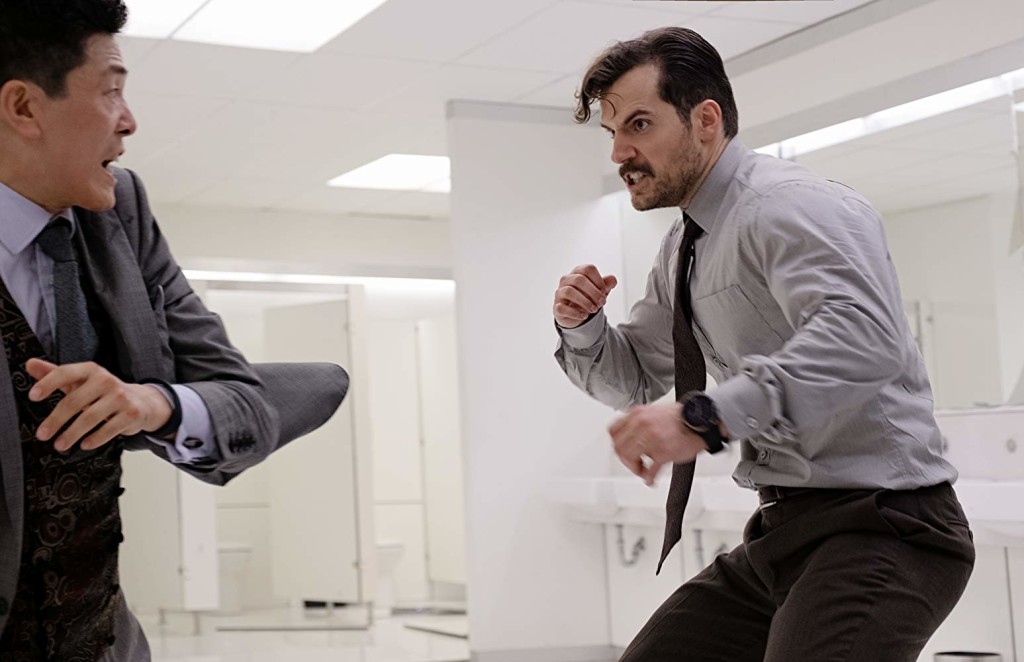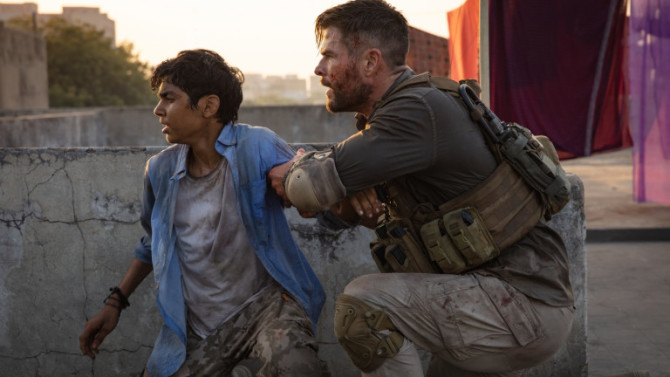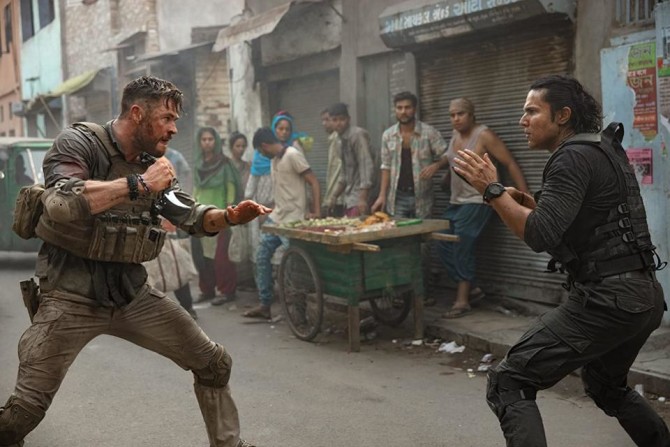Today Carson does the unthinkable. He makes the argument that character development is pointless in an action movie (Okay, he doesn’t go that far but it makes for good clickbait)
Genre: Action
Premise: (from IMDB) A fearless black market mercenary embarks on the most deadly extraction of his career when he’s enlisted to rescue the kidnapped son of an imprisoned Indian crime lord.
About: Here’s writer and producer Joe Russo on how this film came together: “So we were doing Community on TV, and wanted to transition to features with this and thought the smartest thing to do was take this idea we had around an extraction, with this damaged central character, and turn it into a graphic novel. That gave us a visual document that was easy for a studio executive to pick up during their lunch hour and understand what we were trying to accomplish. A long journey writing and rewriting later, we had conversations while shooting Infinity War and Endgame with Hemsworth and Sam Hargrave, and when we put the movie together, that’s when Netflix came into the conversation.”
Writer: Joe Russo (based on his own graphic novel)
Details: about 2 hours long
Extraction may have just done for stunt coordinators what Quentin Tarantino did for video store workers. After Chad Stahelski and David Leitch showed the world the untapped potential of stunt coordinators with their breakout feature, “John Wick,” Sam Hargrave has now proven that the path from stunt coordinator to director is no fluke. His knack for coordinating action has resulted in one of the best action sequences I’ve ever seen.
But outside of his nutso single-take set piece for the history books, was Extraction actually a good movie? Or is it just the world’s best action movie resume for a director looking to impress the studios?
Let’s begin with the plot. I never understood exactly what was going on in Extraction. I knew that Chris Hemsworth had rescued a rich 12 year old Indian boy from some bad people who had kidnapped him. And I knew that some other badass Indian dude wanted the kid and was chasing Hemsworth throughout the movie. But I couldn’t tell you any of the other parties involved beyond that. Which is why I’m glad there’s Wikipedia. Here’s what they say…
Tyler Rake, a black-market mercenary and former Australian Special Air Service Regiment, is recruited by fellow mercenary Nik Khan to rescue Ovi Mahajan Jr., the son of India’s biggest drug lord Ovi Mahajan Sr., from Dhaka, Bangladesh because he is held for ransom by Bangladesh’s biggest drug lord, Amir Asif.
Whilst Rake is in the process of extracting Ovi from his kidnappers, Saju, a former Special Forces soldier and Ovi’s father’s chief henchman, attempts to bring the boy back, doing so in fear of his family being killed and in order to avoid paying the substantial ransom money, which neither he nor Ovi’s currently incarcerated father can afford.
(Kudos, by the way, to Joe Russo for creating the most action hero name ever)
Our boy Tyler Rake is able to secure the kidnapped boy easily and begin his extraction. But on the way to the checkpoint, he’s ambushed, forcing him and the boy into the heart of Bangladesh, where he’s relentlessly hunted down by this Saju guy. It seemed to me like they had the same goal (get the boy back to his dad) so I don’t know why they were against each other. But what are you going to do? It’s a Netflix action movie.
For the longest time, I’ve been obsessed with this topic of how to make an action flick stand out on the page. Or, more specifically, how do you make “generic” interesting?
Because the reality is almost every straight action movie is built on a generic premise. Taken – save my daughter. John Wick – Take down the Russian mafia. Extraction – Extract a kid from the bad guys.
Action is such a generic genre that a fight scene that takes place in a bathroom can be heralded as a step forward for the genre.
Here’s the truth of the matter. The two elements that have the biggest impact on action are a) the directing and b) the casting/acting of the lead actor. You can see what Liam Neeson and Bruce Willis did for Taken and Die Heard respectively. And you can see how much Chad Stahelski and David Leitch elevated John Wick with their action choreography.
The thing that elevates Extraction is an incredible one-shot midpoint set piece that has Rake and the kid car-racing through then running through the heavily populated Bangladesh slums with a SWAT TEAM, police, and a crazed fellow extractor in pursuit. It is unforgettable in its brutality, realism, creativity, and relentlessness. And that’s 100% directing.
There was one point in particular where they’re out on the street and there were probably 800 locals running around and I sat there wondering, are these all background actors? Or are they shooting in a real place and just allowing real people nearby? While that may sound ridiculous when you consider the legal ramifications of doing such a thing, the fact that I genuinely wasn’t sure is a testament to how realistic this sequence was. I don’t know too many directors who would’ve even have attempted it, much less pulled it off.
So does that mean there’s nothing action writers can do? Do we come up with yet another generic action premise and write lots of generic action set pieces and hope we’re that one script that gets picked out of the action slush pile to be made? Or is there something we can learn from these successful action films that goes beyond directing? That goes beyond Liam Neeson delivering the most famous challenge ever to a bad guy?
Here are four things action writers can do to improve their scripts.
The single best thing you can do is create a sympathetic main character. This is true for all movies. But it’s especially true for action movies because they don’t have a lot of character development. We’re never going to connect with a character in an action movie the way we’ll connect with one in a drama like, say, JoJo Rabbit, A Star is Born, or Marriage Story.
Dramas are built to explore the inner workings of people. Action, which is built to explore the external adventures of people, can’t compete with that on a character level.
However, a sympathetic main character can supersede depth when done well. When we feel sympathy for someone, we want them to succeed, regardless of how well we know them. The trick is, it has to be organic.
Liam Neeson in Taken is a great example. The thing that makes him sympathetic is that he was absent for most of his daughter’s life and now that he’s retired, he desperately wants to make up for that lost time. He wants to be a huge part of her life. That’s organic to the situation since the situation is about his daughter getting kidnapped.
If the writer instead would’ve had Liam Neeson recovering from alcoholism, going to AA meetings, and had him help another alcoholic in the group, sure, that is a sympathetic action. But what the hell does it have do with a movie about a former black ops agent whose daughter was kidnapped by international criminals? Make sure the sympathy is organic.
Tip number 2 might surprise you: Don’t turn your action movie into a character drama. If you read a lot of screenwriting websites, you’d think that the most important thing in writing action is creating characters with complex backstories and fully-fleshed out character arcs and tons of inner conflict. You certainly want some of that. But that’s not what action movies are for. They’re for action. Nobody leaves an action flick talking about the monologue where the hero remembers some valuable advice his mother gave him.
Aim to get the majority of your character stuff taken care of in the first act when you’re setting your hero up. Then have one or two ‘character reveals’ later in the script that provide more context to your character. Otherwise, keep your eyes on the prize and focus on the action. Cause when you try and make your action movie a character drama, you get Gemini Man. Nobody – and I mean nobody – wants Gemini Man.
Next is to put every creative atom in your body to work on creating strong original set pieces. It’s an action movie. If your action scenes are the same as action scenes we’ve seen before, we’ll get bored. And I don’t care how you get this across to the reader. If you have to tell them straight up, like Extraction that, “The next 20 page action scene will take place all in one take,” do it. Action is boring to read (“Bam bam. Pow. He ducks. He shoots. He punches”) so any trick you have up your sleeve, use it.
Creativity is essential when writing action. If you don’t have at least two set pieces that have never been seen before, don’t send your script out to anyone.
Finally, give us at least TWO unexpected plot beats somewhere in your movie. Like I said. Action is inherently boring to read. So you need to keep the reader on their toes. I was actually bored through the first 35 minutes of Extraction. It was all by the book. But the second Rake nears the extraction point and he realizes that something’s gone horribly wrong and they’re being ambushed, the movie turned a corner. I specifically remember sitting up after that moment and thinking, “Okay, we have a movie now.”
To help you, here’s a little saying you should have on repeat in your head: “Nothing should go according to plan.”
Straight action is always going to be the most generic genre. So you have to separate yourself from the pack somehow, despite the fact that your toolset is limited. Follow the advice above and you’ll come out on the other side better than most of your competition.
[ ] What the hell did I just watch?
[ ] wasn’t for me
[xx] worth the stream
[ ] impressive
[ ] genius
What I learned: Dueling Badasses – If it was just Rake going up against a bunch of faceless cops the whole movie, it would’ve lost a worth the stream [x] from me. What made it double worth the stream was this fellow badass who would keep catching up to Rake and battle him to near death every time.
What I learned 2: No excuses. Joe Russo – JOE RUSSO! – wrote this. Joe Russo is married. Joe Russo has two kids. Joe Russo was a director on two of the biggest movies ever made. Joe Russo just shot another movie this year with Tom Holland (Cherry). Joe Russo has started a production company with his brother where they’re trying to become the next Bad Robot. Yet Joe Russo still found time to write this script. No excuses, guys. No excuses.





